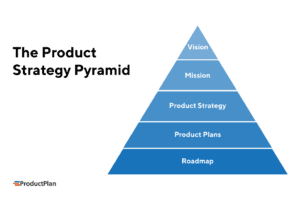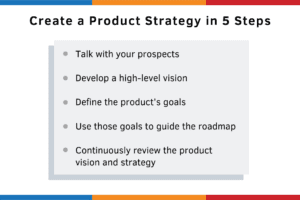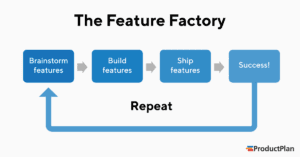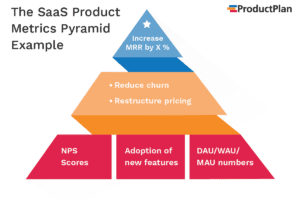What is a Product Strategy?
A product strategy is a high-level plan that defines your product goals throughout its life cycle and how it will support the organization’s goals. The product strategy will also answer who the product will serve and how it will benefit them. These plans are then brought to life on the roadmap.
There’s no single blueprint for a product strategy, but the good ones have a handful of things in common.
1. They have a purpose. Building a product just for the sake of creating and maintaining something isn’t a strategy; that’s busywork. Products should have a raison d‘être and exist for something beyond themselves. Figuring out what that is and getting the entire organization to buy into that is step one.
2. Understand customer needs and how they’re evolving. All products need customers, so any product strategy should be based on meeting their requirements. Since customers don’t always know exactly what they want, the product strategy must bridge the gap between what customers say and what they need. Just as importantly, customer needs aren’t static. They change over time, and the product must adapt to match.
3. Understand your value chain and how it’s evolving. Products don’t exist in a vacuum. Neither do its users. The product strategy must incorporate how it fits into the larger ecosystem, determining where it adds value and where friction points remain. As that ecosystem changes, the product’s role within it may also evolve.
4. Determine what change is likely to happen. Although strategic thinkers don’t possess psychic powers, they should cast an eye toward the future and anticipate likely disruptive forces that limit or expand the product’s opportunities for growth and usage.
5. Define actions against those changes. With a view on the horizon, what must be included in the product strategy to mitigate those disruptions or seize upcoming opportunities?
6. Measure success and course correct. There’s no way to know if a strategy is successful if no one’s keeping score. While the strategy itself shouldn’t be hitting specific metrics, tracking progress and KPIs illuminate progress and offer potential warning signs.
Download The Product Strategy Playbook ➜
The Power of Product Strategy
Your product strategy is the key to connecting business objectives with the product. Companies have many different types of strategies, all built on one another to align the team properly. Making a great product strategy requires understanding where it sits in the middle of the high-level corporate vision and roadmap initiatives.

Vision
Starting from the top, most companies create a corporate vision. It is the entire outfit’s reason for being. In a company’s early stages, the company and the product may be viewed synonymously. But that should rapidly change as the product rolls out and the business becomes more complex and diversified.
A corporate vision is the highest-level view of what the company wants to be. LinkedIn wants to “create economic opportunity for every member of the global workforce.” IKEA’s vision “is to create a better everyday life for many people.” Nike wants to “bring inspiration and innovation to every athlete* in the world. (*If you have a body, you are an athlete.)”
These visions are fuzzy on the details and big on inspiration. They intend to motivate employees, excite consumers, and boil down their philosophy into an extremely brief sentence or two.
A product vision statement is a static, aspirational statement about what the product aims to achieve. It’s who we are today and where we want to be.
Product visions are short and sweet. They don’t need ongoing updates because they’re also (relatively) timeless. Google wants “to organize the world’s information and make it universally accessible and useful.”
Mission
Just beneath the corporate vision is the company mission. Now we start getting into tactics, albeit at an extremely high level. The mission talks about how the company will make that vision a reality.
These aren’t exactly actionable business plans, but they at least give some sense of how a vision might be realized. From a mission statement, you can then create a strategy, and that is where the product comes into play.
Product missions are also extremely brief. Think StubHub’s “Where fans buy and sell tickets.” Everyone reading it understands the big idea behind the product, but it isn’t limiting how to fulfill that mission.
Missions spell out the product’s overall purpose and what you want to do with your team. It can come before in-depth customer research and persona development, as it’s still not specifying implementation.
Strategy
With a defined product vision and mission, a product strategy can then take shape. The product strategy is the art of finding and exploiting leverage in the competitive landscape to achieve your purpose (as defined in the product vision/mission).
Ambition is not a strategy; it must be more tactical. Strategies need a sense of realism, representing accomplishable outcomes.
However, product strategies also seldom include numbers or metrics because those make it too specific. Being No. 1 isn’t a strategy, either. That’s fodder for a mission or vision.
In the webinar below, we discuss how to treat your strategy as a product.
Product plans or initiatives
Residing one level below a strategy are plans for the product. Far more granular and specific, these are where the rubber meets the road, resources get allocated, budgets are defined, and schedules set. Project plans are all about actual execution, with no wiggle room for intent and targets.
With this hierarchy now defined, it’s time to get into what this means for products.
How to craft your product strategy
Product strategies aren’t easy to create… if they were, every entrepreneur would be a smashing success, and all startups would turn into unicorns. But following a simple playbook ensures you haven’t forgotten anything.
Here are five steps to a winning product strategy:

Factor in the rest of the field
Just like a product manager shouldn’t devise an entire product strategy all by themselves, a product strategy can’t ignore what else is out there. Rare is the case where a product doesn’t face direct competitors or viable alternatives for the services and functions it provides.
Conducting a competitive analysis takes a disciplined approach to evaluating the other players vying for potential customers. This exercise should cast a wide net in terms of what solutions prospects are using or considering.
Each alternative’s attributes must be assessed, along with which features and capabilities resonate with the target market. Not every checkbox on the feature matrix matters the same to actual buyers and users, as organizations want to avoid becoming feature factories in their quest to “catch up.”

Pricing strategies must also take competitors into account. The product strategy may entail a premium price point or undercutting the competition, but it’s hard to come up with a price tag without knowing what the rest of the market charges.
Additionally, product managers shouldn’t be fooled or talked out of playing a role in the pricing strategy. Despite what sales or business development might say, product management has the best understanding of a product’s COGS (cost of goods sold), and its real value to different customers.
Instead, product management should play an active part in the product’s pricing strategy, collaborating with other parts of the business to devise a model that drives growth and hits the company’s revenue and profitability goals.
Read the Power of SaaS Pricing Experiments ➜
What’s the product leader’s role in product strategy?
From a product’s conception until its final sunset, product management’s role must adapt to the different lifecycle stages. Strategy never goes away, but it does have two distinct phases.
Product management throughout the product lifecycle
There is the initial strategy development, which begins with ideation. The strategy goes through rapid evolutions as research rolls in, MVPs are designed and built, feedback is collected, and the product morphs and changes while trying to find product-market fit.
Download the Product-Market Fit Book ➜
Product managers spend far more of their time developing and refining the strategy during this stage than at any other time. There is just so much learning occurring and unknown variables to define.
Once the product gets traction, product managers take on a different set of responsibilities. Attention shifts to growth and retention, usually followed by managing a decline or reinvention. Here the product strategy itself shouldn’t see as many significant shifts, although there’s never a time when the topic isn’t part of a product manager’s portfolio.
Staffing up
These lifecycle stages also influence the makeup of the product team itself. Different phases require varying skills, not to mention the volume of work to be done. With this in mind, product management must take a strategic approach to staffing.
Hiring product managers isn’t as straightforward as some other disciplines. There’s no ideal resume or degree for product management, and the role requires a unique combination of soft skills, creativity, and technical acumen.
Because these demands differ throughout the product lifecycle, product managers must carefully consider when is the right time to scale their team. The ideal team size is also highly dependent on the complexity of the products, the number of products in the overall portfolio, and which areas deserve more dedicated attention.
Download From Product Manager to Product Leader ➜
Collaborating with other teams
Despite building out a product team, product strategy meetings must involve other parts of the organization. No matter how many great ideas and talented individuals comprise the product management ranks, input from other departments is crucial.
Keeping these product strategy meetings from going off the rails is yet another challenge product managers face. Everyone brings their biases, pet projects, favorite shiny objects, and anecdotal evidence to the table.
Better product strategy meetings manage to incorporate these varied insights without turning into a free-for-all by keeping everyone on topic, putting all other side issues in your Parked Items, and setting clear rules of engagement and goals for these sessions. Checking egos at the door, unemotionally defending firmly held beliefs, and communicating the results are other secrets to success.

How to tie product metrics to a product strategy?
While a viable product strategy must encompass more than a series of measurable targets, metrics play a vital role in defining and executing the product strategy.
Product managers don’t have to reinvent the wheel when it comes to defining product metrics. There’s an existing set of well-understood and valuable metrics at their disposal, assuming the instrumentation and reporting are in place. The fun/tricky part is deciding which ones to concentrate on.
The product’s maturity will also dictate which metrics are most relevant to that phase of the product strategy. Once a product is getting used and the analytics are rolling in, product managers can use metrics to adjust and enhance the product strategy. The data provides a valuable feedback loop and can quantify the anecdotal observations.

How to align the roadmap under the product strategy?
The product roadmap is the primary vehicle for transforming product strategy from theory to reality. It lays out how the product will evolve to achieve its key goals and communicate to everyone the priorities.
But translating a strategy and aligning the roadmap underneath it isn’t a trivial undertaking. It requires a lot of work in advance to identify what matters most to key organizational stakeholders and extensive planning and prioritization.
Download the Product Manager’s Guide to Prioritization ➜
One of the biggest mistakes product managers can make in this area is thinking they can—or should—do it alone. Failing to conduct critical strategic conversations ahead of time can spell doom for a product roadmap and tarnish product management’s reputation.
Incorporate stakeholder concerns into the process and product managers shouldn’t assume they know what each person cares about until they’ve discussed it personally with everyone. Not only is this a fact-finding opportunity for the roadmap makers, but it also provides another opportunity to reinforce the details of the product strategy with those stakeholders.
Building the roadmap
Much like a product strategy can only come after its vision and mission have been defined, it’s also logical to adopt a top-down strategy for the roadmap itself. This process intrinsically links everything in the roadmap to the high-level goals the organization established for the product. The strategy becomes a common, universal thread running through everything on the roadmap.
Strategy-based roadmapping also makes for a better team experience. It clears up any “why” questions and uncertainties. It allows the team to focus on what will have the most significant impact on executing the strategy everyone’s on board with.
But assessing the impact of potential roadmap items goes beyond simply confirming they “fit” into the product strategy. There are undoubtedly dozens of enhancements, features, and modifications that sync up with the product strategy, but their impacts are far from equal. Deciding which initiatives deserve resources and a coveted slot on the product roadmap is the tough part.
Download Your Free Guide to Product Roadmaps ➜
Playing the numbers game.
One method is letting the numbers call the shots. In this case, that means adopting a data-driven approach to roadmapping by prioritizing projects that improve specific key metrics.
Data-driven product roadmaps embrace this quantifiable attitude by basing every decision on how it will influence particular measures of success. This tactic is great for building consensus since it’s hard to argue with data. But the “art” of a data-driven product roadmap is figuring out which metrics matter with regards to the product strategy.
Narrowing the field down to just a handful of measures of progress and success keeps the organization focused. Without a select few metrics—or a single North Star metric—to guide the way, the picture can get cloudy.
Vanity metrics can obscure the numbers that matter, as can metrics that were once critical but are now less relevant and meaningful. And if the obsession with specific measures goes too far, decision-making can ignore the customer experience itself, not to mention product managers’ sanity and happiness.
Results While a data-driven roadmap intends to move the needle on KPIs, sometimes the desired results are a little less measurable. Here’s where outcome-riven roadmapping can play a rol
Results-oriented roadmapping
Instead of saying the goal is improving a specific KPI, these product roadmaps value what will be possible after each initiative is complete. It gets out of the feature-specific mindset, leaving the implementation details intentionally fuzzy as the focus shifts toward the result. It could be anything from saving customers time when completing a task to unlocking an entirely new market for the product by adding additional functionality.
Outcome-driven roadmaps don’t ignore metrics, but they continually reevaluate which measurements are most important to track success against specific objectives. Outcomes determine the KPIs, not the other way around.
Forgoing features for themes
Product roadmaps have long been synonymous with features and delivery dates. Here’s what we’re building. Here’s when it will be ready. Things were sometimes grouped, but in general, it’s typically just a laundry list of what’s next on the docket.
But product roadmaps can and should be so much more than high-level project plans. A product roadmap is a unifying artifact that can get an entire organization excited about how the product vision and mission will unfurl. But the more specific a product roadmap gets, the less useful it becomes.
Instead of telling a story, it spells out a schedule. And that schedule is full of things for people to question, debate, and complain about. Plus, they’re outdated almost as soon as they’re exported, causing additional drama when false expectations are set and not met.
Moving to feature-less roadmaps spares everyone in the organization from drowning in details and nitpicking over dates and specifics. By basing product roadmaps on themes, the focus stays on strategy, goals, and outcomes. It’s far easier to align stakeholders and keep coworkers motivated and excited about the future this way than with a chronological litany of enhancements.
Theme-based roadmaps also require fewer updates and revisions. Since they’re less granular by definition, minor adjustments to dates and specific implementation details don’t warrant a modification.
Download Feature-less Roadmaps: Unlock Your Product’s Strategic Potential ➜
How to stay accountable with your product strategy
A product strategy’s viability and performance reflect directly back on product management and its credibility. If it seems out-of-step with reality or isn’t delivering results, the blame and finger-pointing will always land on product managers.
With this in mind, product managers should be fully confident in their product strategy. If there’s anything shaky in its foundation, they have to immediately investigate and mitigate any shortcomings, errors, or oversights.
Inherited product strategies
Not everyone is there from Day One, so some product teams find themselves managing products where someone else created the initial strategy. However, this doesn’t mean it should be scrapped, and everyone should start from scratch.
The team should unpack for themselves, ensuring any misunderstandings aren’t personal. The current strategy’s meaning to stakeholders should be determined, as historical drivers and beliefs fuel it.
Most importantly, revisit the assumptions used to craft the existing strategy, challenging them when appropriate. Markets evolve, new research uncovers additional things, and the current strategy’s underlying basis may no longer be valid.
Avoid stale strategies
Product strategies should be revisited regularly (monthly or quarterly is a good cadence). Start with the assumptions and then bounce alternatives and new things against them. If the strategy stands up to this scrutiny, it’s still in good shape. If not, it’s probably time for a refresh.
Frequent strategy revisions and mid-course, minor corrections are more accessible than making a full-scale change after not revisiting it for a while. Persistent reevaluation also protects product management’s trust and reputation as the strategy isn’t drastically changing all the time.
It’s also prudent to revisit user personas. As usage grows, it may turn out the people using the product may not exactly match the initial crop of personas used in earlier strategy development. Plus, there may be entirely new markets finding value in the product that wasn’t part of the original plan.